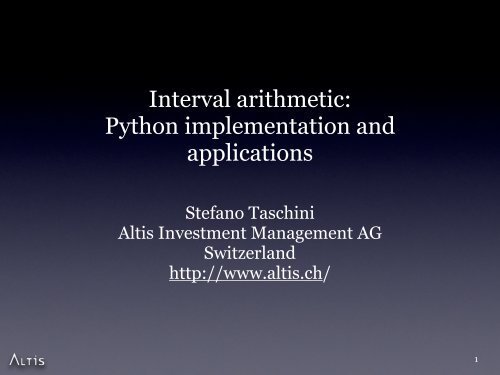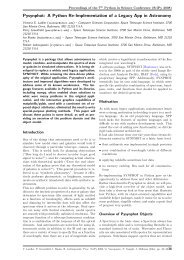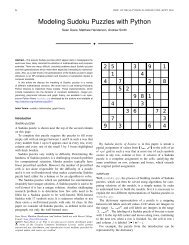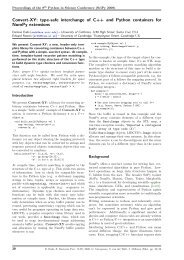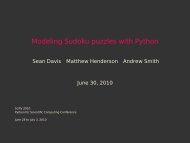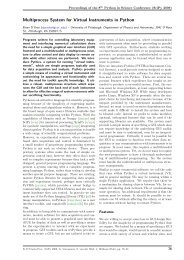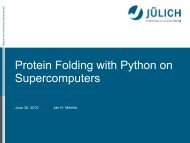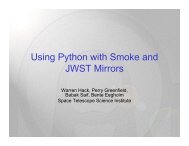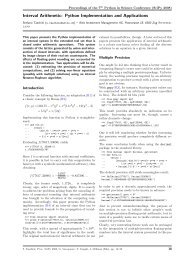Interval arithmetic - SciPy Conferences
Interval arithmetic - SciPy Conferences
Interval arithmetic - SciPy Conferences
You also want an ePaper? Increase the reach of your titles
YUMPU automatically turns print PDFs into web optimized ePapers that Google loves.
<strong>Interval</strong> <strong>arithmetic</strong>:<br />
Python implementation and<br />
applications<br />
Stefano Taschini<br />
Altis Investment Management AG<br />
Switzerland<br />
http://www.altis.ch/<br />
1
An example (1)<br />
f(x, y) =(333.75 − x 2 )y 6 + x 2 (11x 2 y 2 − 121y 4 − 2)<br />
+5.5y 8 + x/(2y)<br />
>>> def f(x,y):<br />
... return (<br />
... (333.75 - x**2)* y**6 + x**2 *<br />
... (11* x**2 * y**2 - 121 * y**4 - 2)<br />
... + 5.5 * y**8 + x/(2*y))<br />
>>> f(77617.0, 33096.0)<br />
1.1726039400531787<br />
2
An example (2)<br />
>>> from gmpy import mpf<br />
>>> f(mpf(77617), mpf(33096))<br />
mpf(’-4.29496729482739605995e9’)<br />
>>> from pprint import pprint<br />
>>> pprint([f(mpf(77617, n), mpf(33096, n)) for n in range(53, 65)])<br />
[mpf(’-4.29496729482739605995e9’),<br />
mpf(’-4.29496729482739605995e9’,54),<br />
mpf(’-4.29496729482739605995e9’,55),<br />
mpf(’-4.29496729482739605995e9’,56),<br />
mpf(’-4.29496729482739605995e9’,57),<br />
mpf(’-4.29496729482739605995e9’,58),<br />
mpf(’-4.29496729482739605995e9’,59),<br />
mpf(’-4.29496729482739605995e9’,60),<br />
mpf(’-4.29496729482739605995e9’,61),<br />
mpf(’-4.29496729482739605995e9’,62),<br />
mpf(’-4.29496729482739605995e9’,63),<br />
mpf(’-4.29496729482739605995e9’,64)]<br />
3
An example (3)<br />
>>> from decimal import Decimal, getcontext<br />
>>> def fd(x,y):<br />
... return (<br />
... (Decimal(’333.75’)-x**2)* y**6 + x**2 *<br />
... (11* x**2 * y**2 - 121*y**4 - 2)<br />
... + Decimal(’5.5’) * y**8 + x/(2*y))<br />
>>> fd(Decimal(77617), Decimal(33096))<br />
Decimal("-999999998.8273960599468213681")<br />
>>> def with_prec(n, f, *args):<br />
... getcontext().prec = n<br />
... return f(*(Decimal(x) for x in args))<br />
>>> pprint([with_prec(n, fd, 77617, 33096) for n in (28, 29)])<br />
[Decimal("-999999998.8273960599468213681"),<br />
Decimal("100000001.17260394005317863186")]<br />
4
An example (4)<br />
f(77617, 33096) = − 54767<br />
66192 = −0.827396 . . .<br />
>>> from interval import interval<br />
>>> print f(interval(77617.0), interval(33096.0))<br />
interval([-3.54177486215e+21, 3.54177486215e+21])<br />
5
Martelli’s example<br />
>>> from interval import imath, interval<br />
>>> def f1(x):<br />
... return imath.sqrt(x+1) - imath.sqrt(x)<br />
>>> f1(9876543.21)<br />
interval([0.00015909901640043245, 0.00015909902822386357])<br />
>>> def f2(x):<br />
... return 1/(imath.sqrt(x+1) + imath.sqrt(x))<br />
>>> f2(9876543.21)<br />
interval([0.00015909902173878482, 0.00015909902173878517])<br />
6
Functions of intervals (1)<br />
y<br />
y<br />
f(b)<br />
f(a)<br />
f(a)<br />
a<br />
b<br />
x<br />
f(b)<br />
a<br />
b<br />
x<br />
7
Functions of intervals (2)<br />
R ∪ {−∞, +∞}. Let f([a, b]) be the image of the bounded interval, equation<br />
closed interval [a, b] under the function f. Real analysis<br />
result.<br />
teaches that if the interval is bounded and the The lattice generated by t<br />
function is continuous over the interval, then f([a, b]) y real set, L(IR ∗ ), is the sm<br />
is also a closed, bounded interval, and, more significantly,<br />
2 ing IR ∗ that is closed und<br />
this extension accomodate<br />
[<br />
]<br />
the union of two intervals<br />
f([a, b]) = min f(x), max (1) in the lattice can always b<br />
x∈[a,b] x∈[a,b]<br />
of closed intervals in R ∗ . I<br />
Computing the minumum and maximum is trivial if<br />
the function is monotonic (Figure 1), and −1/4 also for<br />
the non-monotonic standard mathematical functions 0<br />
>>> k = interval([0, x 1]<br />
represents the the union [0<br />
The intervals 2 [0, 1], [2, 3],<br />
(even-exponent power, cosh, sin, cos...) these are relatively<br />
easy to determine.<br />
connected components of k<br />
sists of only one componen<br />
>>> interval[1, 2]<br />
interval([1.0, 2.0])<br />
signifying the interval 8[1, 2
Functions of intervals (3)<br />
y<br />
a<br />
f(b)<br />
f(a)<br />
b<br />
x<br />
[a, b] −1 =[−∞, +∞] ?<br />
[a, b] −1 =[−∞,a −1 ] ∪ [b −1 , +∞] ?<br />
9
<strong>Interval</strong>s in Python (1)<br />
>>> k = interval([0, 1], [2, 3], [10, 15])<br />
>>> interval[1, 2]<br />
interval([1.0, 2.0])<br />
>>> interval(1, 2)<br />
interval([1.0], [2.0])<br />
k = [0, 1] ∪ [2, 3] ∪ [10, 15]<br />
>>> interval(1), interval[1]<br />
(interval([1.0]), interval([1.0]))<br />
10
<strong>Interval</strong>s in Python (2)<br />
>>> interval[-2,+4].inverse()<br />
interval([-inf, -0.5], [0.25, inf])<br />
>>> interval[10] / interval[3]<br />
interval([3.333333333333333, 3.3333333333333339])<br />
>>> imath.exp(1)<br />
interval([2.7182818284590451, 2.7182818284590455])<br />
>>> imath.log(interval[-1, 1])<br />
interval([-inf, 0.0])<br />
>>> print imath.tanpi(interval[0.25, 0.75])<br />
interval([-inf, -1.0], [1.0, inf])<br />
11
Dependency<br />
Dependency<br />
Not always is one inclined to find the image closure of<br />
Not always is one Dependency inclined to find (1) the image closure of<br />
a given a given functionon a given interval. Even for for a asimple<br />
function functionlike likef(x) = x 2 − x one might be beinduced inducedtoto<br />
compute f([0, 2]) by interpreting the expression x<br />
compute f([0, 2]) by interpreting the expression 2 −<br />
x 2 x<br />
− x<br />
using interval <strong>arithmetic</strong>. Interestingly, whereas<br />
using interval <strong>arithmetic</strong>. Interestingly, whereas<br />
the tervals: three expressions lead to different results with intervals:<br />
>>> (lambda x: x**2 - x)(interval[0,2])<br />
Incidentally, graphic inspection (Figure 3) immediately<br />
reveals that ¯f([0, 2]) = [−1/4, 2]. The three inif<br />
g(<br />
The<br />
of d<br />
roun<br />
∀x ∈ R, x 2<br />
∀x ∈ R, x 2 − x = x(x − 1) = (x − 1/2) 2 Floatin<br />
− x x(x 1) (x − 1/2) 2 − 1/4<br />
− 1/4 subset<br />
the three expressions lead to different results with in-<br />
accordi<br />
the pro<br />
with theso<br />
>>> interval([-2.0, (lambda x: x**2 4.0]) - x)(interval[0,2])<br />
necessi<br />
interval([-2.0, >>> (lambda x: x*(x 4.0]) - 1))(interval[0,2])<br />
an arbi<br />
>>> interval([-2.0, (lambda x: x*(x 2.0]) - 1))(interval[0,2]) Of the<br />
interval([-2.0,<br />
>>> (lambda x: (x2.0])<br />
- 0.5)**2 - 0.25)(interval[0,2])<br />
dard, r<br />
interval([-0.25, >>> (lambda x: (x - 0.5)**2 - 0.25)(interval[0,2]) −∞, o<br />
Incidentally, graphic inspection (Figure 3) immediately<br />
reveals that ¯f([0, 2]) = [−1/4, 2]. The three<br />
interval([-0.25, 2.0])<br />
inif<br />
g(X)<br />
The ex<br />
of depe<br />
roundin<br />
Reals<br />
Rea<br />
Floa<br />
subs<br />
acco<br />
with<br />
nece<br />
an a<br />
Of t<br />
dard<br />
−∞<br />
12
Dependency (2)<br />
2<br />
y<br />
x<br />
−1/4<br />
0 2<br />
13
Newton (1)<br />
N(ξ, η) =ξ − f(ξ)/f ′ (η)<br />
(x 2 − 1)(x − 2) = 0<br />
>>> interval[-100, 100].newton(<br />
... lambda x: (x**2 - 1)*(x - 2),<br />
... lambda x: 3*x**2 - 4*x -1)<br />
interval([-1.0], [1.0], [2.0])<br />
cos(πx/3) = 0.5<br />
>>> print interval[-10, 10].newton(<br />
... lambda x: imath.cospi(x/3) - 0.5,<br />
... lambda x: -imath.pi * imath.sinpi(x/3) / 3)<br />
interval([-7.0, -7.0], [-5.0, -5.0], [-1.0, -1.0], \<br />
[1.0, 1.0], [5.0, 5.0], [7.0, 7.0])
s f.<br />
the <strong>arithmetic</strong> operations, represented<br />
pen that for any two arbitrary H, K ∈<br />
∉ L(IF). It is therefore necessary to<br />
closure of the interval <strong>arithmetic</strong> oper-<br />
+ K) H ⊖ K = I(H − K)<br />
× K) H ⊘ K = I(H ÷ K)<br />
effect of the float enclosure on the ariths<br />
is easily verifiable:<br />
10] / interval[3]<br />
33333333333333, 3.3333333333333339])<br />
e rounding mode of the processor’s<br />
nit ensures that <strong>arithmetic</strong> operations<br />
or down. In the Python implemend<br />
here, ctypes provides the low-level<br />
he standard C99 functions as declared<br />
falling back to the Microsoft C runtime<br />
e former are not present. A lambda extes<br />
the lazy evaluation that is required<br />
es in the interval.fpu module:<br />
rval import fpu<br />
lambda: 1.0/3.0)<br />
333331<br />
mbda: 1.0/3.0)<br />
333337<br />
common implementations of the C<br />
ematical library do not provide the<br />
olling how transcendetal functions are<br />
of this work therefore required implen<br />
binding for CRlibm, the Correctly<br />
ematical Library [R8].<br />
libm<br />
p_rd(1.0)<br />
90451<br />
N(ξ, η) = ξ − f(ξ)/f ′ (η) (4)<br />
Newton (2)<br />
If f(x) = 0 has more than one solutions inside [a, b],<br />
then, by Rolle’s theorem, the derivative must vanish<br />
somewhere in [a, b]. This in turn nullifies the denominator<br />
in equation (4), which causes ¯N({ξ}, [a, b]) to<br />
possibly return a lattice interval consisting of two disjoint<br />
components, in each of which the search can<br />
continue. The complete algorithm is implemented in<br />
Python as a method of the interval class:<br />
def newton(self, f, p, maxiter=10000):<br />
def step(x, i):<br />
return (x - f(x) / p(i)) & i<br />
def some(i):<br />
yield i.midpoint<br />
for x in i.extrema.components:<br />
yield x<br />
def branch(current):<br />
for n in xrange(maxiter):<br />
previous = current<br />
for anchor in some(current):<br />
current = step(anchor, current)<br />
if current != previous:<br />
break<br />
else:<br />
return current<br />
if not current:<br />
return current<br />
if len(current) > 1:<br />
return self.union(branch(c) for<br />
c in current.components)<br />
return current<br />
return self.union(branch(c) for<br />
c in self.components)<br />
In this code, step implements an interval extension<br />
of equation (4), with the additional intersection with<br />
the input interval to make sure that iterations are not<br />
widening the interval. Function some selects ξ: first<br />
the midpoint is tried, followed by the endpoints. The<br />
15
Newton (3)<br />
x<br />
0···<br />
y<br />
4···<br />
8·· ̌<br />
·<br />
12 ∅<br />
·<br />
·<br />
·<br />
16···<br />
x<br />
20···<br />
24 ̌<br />
·<br />
· ∅<br />
·<br />
28· ∅<br />
·<br />
·<br />
0···<br />
32···<br />
36· ̌<br />
4···<br />
8·· ̌<br />
·<br />
16
Notes<br />
• http://pyinterval.googlecode.com/<br />
• http://pypi.python.org/pypi/pyinterval/<br />
• http://conference.scipy.org/slides/<br />
If you are on Windows or Linux:<br />
easy_install py_interval<br />
17


